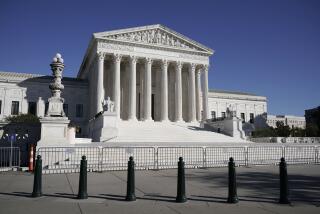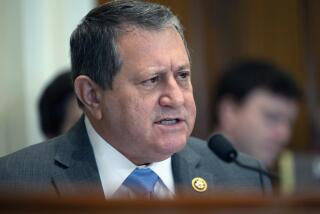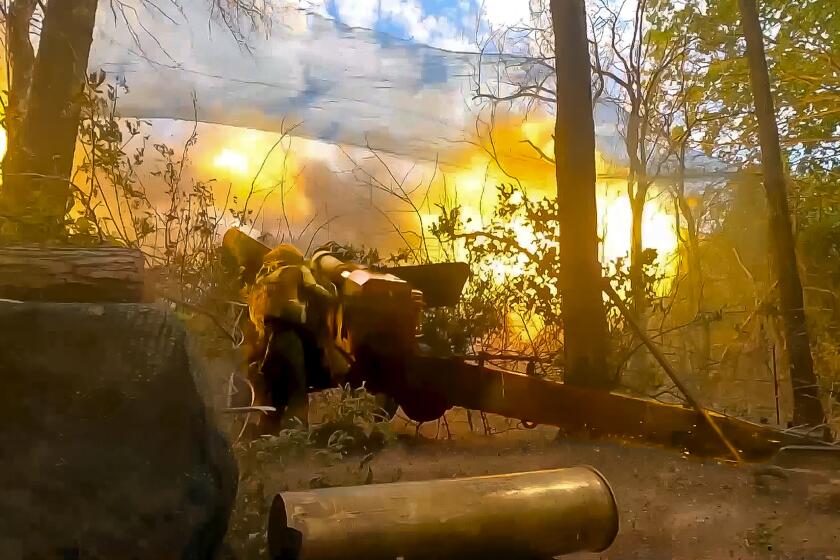Early Scheme to Turn Jets Into Weapons
Khalid Shaikh Mohammed, the Al Qaeda agent believed to have been a key organizer of the Sept. 11 terrorist attacks, spent a year here in the mid-1990s. From the way he behaved, it’s little wonder no one suspected him of being dangerous to anything but his bank account.
Evidence collected by Philippine investigators describes a man far different from the usually abstemious Al Qaeda agent. In Manila, where police say he used the name Abdul Majid, he met associates in karaoke bars and giant go-go clubs filled with mirrors, flashing lights and bikini-clad dancers. He held meetings at four-star hotels. He took scuba-diving lessons at a coastal resort.
When he wasn’t engaged with the go-go dancers, he courted a Philippine dentist. Once, to impress her, he rented a helicopter and flew it over her office, then called her on his cell phone and told her to look up and wave.
Other members of the terrorist cell Mohammed led had local girlfriends as well, and the whole group had a drinking party to celebrate the anniversary of the 1988 Pan Am Flight 103 explosion over Lockerbie, Scotland.
Until recently, little was known about Mohammed’s time here--almost a full year beginning in early 1994. He was known to have played some role in a failed 1995 effort to blow up a dozen U.S.-bound airliners over the Pacific. Now, in re-evaluating that conspiracy in light of new information about Mohammed’s prominence within Al Qaeda, Philippine police have concluded that he was the principal planner of the plot.
A confidential report by the Philippine national police officers who led the original investigation concludes that the airliner plot, code-named Bojinka, was the first step in a sustained effort by Mohammed to refine the use of aircraft as weapons of terrorism.
That effort culminated in the Sept. 11 suicide hijackings, according to the report, a copy of which was provided to The Times.
“It was a strong network continuously hatching plots. After seven years, they were able to do what they started here. That’s the story,” said Col. Rodolfo Mendoza, who led the original investigation.
As evidence that Bojinka was more than just a coincidental foreshadowing of Sept. 11, Mendoza cited the testimony of Abdul Hakim Murad, a licensed commercial pilot and one of the men recruited by Mohammed for the plot. Murad told interrogators that the first two times he was brought to meet Mohammed in Pakistan in 1993, all Mohammed wanted to talk about were aircraft and pilot training.
The Bojinka plot was previously regarded as the creation of Ramzi Yousef, a Kuwaiti explosives expert. The Philippine investigators now believe that Yousef was working directly for Mohammed.
Investigators consider it significant in retrospect that Murad, whose arrest exposed the conspiracy, virtually pleaded with them to listen to information he had about Yousef, but was reluctant to speak of Mohammed at all. Mendoza said it was almost as if Murad was trying to mislead them.
“It’s now clear Khalid was calling the shots,” Mendoza said.
Mohammed, a Kuwaiti national of Pakistani ancestry, is under indictment in the U.S. for his alleged role in Bojinka, which means “big bang.” The U.S. government has offered a $25-million reward for information leading to his capture.
Mohammed, who is believed to be 37, spent most of the 1990s in Pakistan. “He certainly wasn’t a known figure” at that time, said Hamid Gul, a former head of Pakistani intelligence.
Pakistani leadership through the 1990s sympathized with Osama bin Laden’s fundamentalist rhetoric. Mohammad Aftab, then head of Pakistan’s domestic news agency, put it this way: “There were so many of these people around and they were all ‘on our side,’ so no one paid a lot of attention to them.”
This sympathy allowed Mohammed to operate as he pleased in Pakistan, and it was there that he began assembling the members of what would become his Manila cell, according to police. These included Yousef, already a veteran of the 1993 truck-bombing of the World Trade Center, which killed six people and injured more than 1,000; Murad, a school-boy friend of Yousef’s; and Wali Khan Amin Shah, an Afghan.
According to what investigators learned through interrogations, the men seemed to be almost indiscriminate when discussing whom or what they might attack. Among targets they proposed were Benazir Bhutto, then prime minister of Pakistan; the U.S. Consulate in Karachi, Pakistan; U.S. nuclear power plants; and a variety of U.S. government buildings, including CIA headquarters and the Pentagon.
Murad, a Pakistani, told investigators that he was the first to suggest using aircraft to attack buildings after Yousef preached to him about the need for suicide missions.
Mohammed told associates that he chose Manila as his base of operations because he thought he could recruit young men from the Philippines to join the jihad. Investigators believe that another reason was a fledgling Southeast Asian Al Qaeda network, partly funded by Bin Laden’s brother-in-law, Mohammed Jamal Khalifa, who in the early 1990s established an Islamic charity in Manila.
Police believe that the charity, the International Islamic Relief Organization, was a front to finance terrorism.
Khalifa worked with Islamist organizations in the Philippines--Abu Sayyaf and the Moro Islamic Liberation Front--and like-minded organizations in Malaysia and Indonesia headed by Riduan Isamuddin, an Indonesian cleric who goes by the name Hambali.
Hambali and Wali Khan, one of the Manila plotters, were founding board members of a Malaysian company that police believe was created mainly to fund terrorist activities. The company, Konsojaya, was founded in the summer of 1994, just as preparations for the airline plot were being put together in Manila. Wali Khan was involved in the plot, and Mohammed Amin, another Konsojaya director, made frequent trips to Manila while planning was under way. Investigators say Amin’s role appears to have been financial.
The Bojinka plot called for using chemical bombs to blow up 12 U.S. airliners over two days in January 1995. U.S. officials say thousands would have died if the scheme had succeeded.
When the team began to gather in Manila, Mohammed let the plotters stay in a one-room apartment with the explosives while he moved into a considerably more pleasant high-rise apartment he kept in a better part of town.
Because he had moved, Mohammed wasn’t present when Yousef, the explosives expert, accidentally set fire to the apartment in January 1995. When reports of the fire reached a nearby police precinct, a detective was suspicious of the purported cause--firecrackers. Police were on edge because of a quickly approaching visit by Pope John Paul II. The apartment was within a block of where the pontiff was supposed to stay.
When the wary detective, Aida Farsical, went to the scene to investigate the fire, she discovered the bomb-making chemicals. Police also found a laptop computer in the apartment and, when he returned to retrieve it, Murad. The computer contained details of the Bojinka plot. Police also found a dozen passports, pipe bombs and maps of the pope’s route from the airport to the Vatican Consulate; the motorcade was scheduled to pass directly beneath the sixth-floor apartment window.
Police believe the team also was preparing to assassinate the pope.
Murad was arrested after the apartment fire. Two of the other plotters--Yousef and Wali Khan--were captured within a year. They and Murad were later turned over to U.S. authorities. Mohammed and Amin got away.
Because of confusion over the true identities of the escaped suspects, police here were unable to determine clearly Mohammed’s role until he was identified by American authorities as a suspect in the Sept. 11 plot and more information about him became available, the new police analysis states.
Mohammed was charged in the U.S. as a co-conspirator in the Bojinka plot, but the evidence presented against him was scant. In federal court in New York, prosecutors argued that Yousef was the leader. He and Murad were convicted of conspiring to bomb U.S. airliners and sentenced to life imprisonment. Wali Khan was also convicted and awaits sentencing.
In retrospect, Yousef seems too bumbling to have planned much of anything. Over several years, he repeatedly injured himself in accidental explosions, at one point requiring eye surgery in Iran, according to police records.
Mohammed returned to the Middle East later, traveling first to Qatar, where authorities believe he worked for a charity, and then to Pakistan and Afghanistan, where American investigators suspect he rose in the Al Qaeda ranks.
He remains one of the highest-ranking Al Qaeda members at large. Roland Jacquard, a French terrorism expert, said that as recently as late March, Mohammed was in Pakistan recruiting volunteers for suicide missions. German authorities suspect he was involved in the explosion of a truck bomb in Tunisia in April.
Times staff writers Sebastian Rotella in Paris and Tyler Marshall in Islamabad, Pakistan, contributed to this report.
More to Read
Start your day right
Sign up for Essential California for news, features and recommendations from the L.A. Times and beyond in your inbox six days a week.
You may occasionally receive promotional content from the Los Angeles Times.






